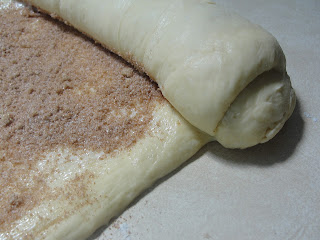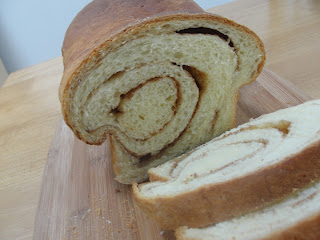When I chose the topic for this month's Bread Baking Day event, I wasn't sure what I was going to choose as my own submission. There are so many beautiful and delicious options that it was very hard to choose just one. But my mind kept returning to a beautiful and utterly swirl-filled bread that I'd made once before, and I just knew that I would take this opportunity to make it again.
I'm talking about the povitica. I originally made the povitica as a Daring Bakers' Challenge, but have been looking for an opportunity to try it again, as everyone in the family truly enjoyed it. And, being the swirliest bread that I have ever made, I knew that now was the time.
The original recipe provided for the challenge was written to make four loaves. When I made the bread for the challenge, I halved the recipe and made two loaves. Today I chose to make just one, so did a little bit of math and quartered the recipe.
The dough comes together pretty easily, but has a few components, including activated yeast, melted butter and beaten egg, so it generates quite a few dishes.
But after some heating, cooling, mixing and kneading, the result is a dough so soft and smooth that some little boy, who shall remain nameless, could not keep his hands off of it.
I set the dough aside to rise and we went about the rest of our morning.
Once little man went down for his nap, it was time to get down to the nitty gritty of this bread.
As a filling, I chose to go with chocolate. The traditional fillings for this type of bread include either nuts, which we avoid in our house due to allergies, or poppy seends, of which I am not a huge fan. So I chose a sure crowd pleaser.
Chocolate.
To my cocoa powder, cinnamon, sugar and chocolate chips, I added boiled coconut milk and butter.
The hot milk melted the chips and the result was a smooth and pretty delicious looking and smelling chocolate spread that was all ready to go.
The dough had risen beautifully, so I carefully deflated it and turned it out onto a well cleaned and well floured counter. I used the two foot by three foot island in my kitchen.
And I rolled out that dough as thinly as I could.
Okay, I probably could have rolled it a little thinner, but I was starting to worry about time, so I stopped when I could see through it, and proceeded to spread on the delicious filling...
...until it basically looked like I'd covered the entire kitchen island with chocolate sauce.
And then we roll! It's a little tough to neatly roll dough that thin, but I made it work...
And then I coiled the rolled dough into a loaf pan.
Phew.
I then put the bread into the oven and (im)patiently waited. It came out just in time to pick little miss up from school, so I turned it out, on its side, on a cooling rack. Turned out so that it wouldn't gather condensation in the pan, creating a soggy bottom, on its side so that it wouldn't collapse on itself.
Which worked alright, but it did wind up slanting the side in a bit...
But that's okay, because it still swirled beautifully!!
It kind of reminds me of zebra stripes, with all of those random dark swirls...
But the most important thing is how tasty it is.
Seriously, I don't think this bread will last until the morning. We've eaten two thirds of it already. I probably should have made two. There is a decent chance that I will be making another one of these before the weekend...
Chocolate Povitica
(slightly adapted from The Gingered Whisk)
To Activate the Yeast:
1/8 cup warm water
1/2 teaspoon sugar
1/4 teaspoon flour
1/2 tablespoon active-dry yeast
For the Dough:
1/2 cup milk (the higher the fat the better) (I used coconut milk)
3 tablespoons sugar
1/2 teaspoon salt
1 egg
2 tablespoons unsalted butter, melted
2 cups flour (approximately)
For the Filling:
1/2 cup milk (the higher the fat the better) (I used coconut milk)
1/4 cup unsalted butter
1 teaspoon vanilla extract
1/4 cup sugar
1 teaspoon cocoa powder
1 teaspoon ground cinnamon
1/2 cup chocolate chips
To activate the yeast:
In a small bowl, stir sugar, flour, and the yeast into the warm water and cover with plastic wrap. Allow to stand for about 5 minutes.
To make the dough:
In a small saucepan, heat the milk up to just below boiling (about 180 F or 82 C), stirring constantly so that a film does not form on the top of the milk. You want it hot enough to scald you, but not boiling. Allow to cool slightly, until it is about 110 degrees.
In a the bowl of your stand mixer, mix the scalded milk, sugar, and salt until combined.
Add the beaten egg, yeast mixture, melted butter, and 1/2 cup of flour.
Blend thoroughly and slowly, add remaining flour, mixing well until the dough just starts to clean the bowl. Don't add too much flour at this point, you still want it to be fairly wet and sticky.
Turn dough out onto floured surface and knead, gradually adding flour a little at a time, until the dough is smooth and does not stick.
Place the dough into a lightly oiled bowl, cover loosely with a layer of plastic wrap and then a kitchen towel and let rise an hour and a half in a warm place, until doubled in size.
While the dough rests, prepare your filling:
In a medium bowl, mix together the sugar, cocoa, cinnamon, flour and chocolate chips.
Heat the milk, butter and vanilla extract to boiling.
Pour the liquid over the chocolate/sugar mixture and stir carefully until all of the chips have melted and the mixture is smooth.
Add the egg and continue to mix thoroughly.
Allow the mixture to stand at room temperature until ready to be spread on the dough.
(If the mixture thickens, add a small amount of warm milk.)
Once the dough and your filling mixture is done and cooled, it is time to assemble the bread.
Generously flour a large surface - a table, a kitchen island - or, if all else fails, clean and flour a sheet and spread it on the floor! You need space for this.
Roll the dough as big and thin as you can. You can use your hands to gently pull and stretch the dough, as well. As you work, try to lift the dough from the surface periodically to both help stretch the dough and to make sure that it is not sticking to your work surface. When you think you have rolled the dough about as thin as you can, try just a little more - this dough as very stretchy and you can probably get it just a bit thinner!
Carefully spread the filling over the stretched dough until it is covered.
Carefully (again!) roll up the dough, starting at a long end, jelly roll style until it is a long, rolled snake.
Once the dough is rolled up into a rope, gently lift it up and place it into a greased loaf pan in the shape of a “U”, with the ends meeting in the middle. You want to coil the dough around itself, as this will give the dough its characteristic look when sliced.
Once the dough is in the pan, cover it loosely with plastic wrap and preheat your oven to 350 degrees. The bread needs to rest for about 15 minutes, which gives your oven just about the perfect amount of time to preheat.
Once the bread has rested and the oven is preheated, put the pan in the oven and bake for 15 minutes at 350 degrees.
After 15 minutes at 350 degrees, lower the oven to 300 degrees and continue to bake for another 45 minutes. Check the bread after about half an hour to make sure it is not getting too brown. If needed, you can tent the bread with foil to keep the top from getting too dark.
When done, allow the bread to cool on a wire rack for at least half an hour.
Enjoy!


























































